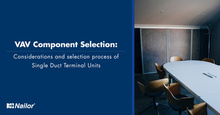Nailor Airwaves is your source for content on relevant topics concerning Nailor Industries, Inc. and the HVAC industry. New product releases, case studies, product & project spotlights, employee interviews, trade publication articles, and general announcements are some of the content types you can expect to find in the Nailor Airwaves.
Nailor Airwaves
VAV System Design: What is your style?

The Houston, Seattle, and Washington DC markets largely specify systems that utilize series fan-powered terminal units in all zones. Dallas and Portland, OR, specify parallel fan-powered units on the exterior with single duct units in the interior. The equipment and configuration of selected terminal units appear to be a matter of style. There are many reasons why different areas could have different design standards. Regardless, analyzing why you would select one style over the other could provide some value.
Equipment Reminder
Terminal units are used within a Variable Air Volume (VAV) System to control the airflow and temperature delivered to a zone. Single duct, parallel fan-powered, and series fan-powered units are connected to an air handling unit (AHU) that supplies the terminal… Read more
AHRI Recognizes Nailor for 3 Years of Success

The American Society of Heating Refrigeration and Air-Conditioning Engineers (ASHRAE) has developed standards that the industry uses to test their Terminal units (ASHRAE Standard 130) and Fan Coils (ASHRAE Standard 79). These documents outline the standard procedure for testing each piece of equipment. Standard 130 outlines terminal unit pressure drop and sound testing, while Standard 79 covers fan coil airflow and cooling/heating capacity testing. Nailor performance data published in our selection software and catalogs are based on these standards.
The American Heating and Refrigeration Institute (AHRI) works with ASHRAE to develop standards for rating equipment. Manufacturers can become members of AHRI by submitting their equipment to yearly testing. … Read more
VAV Diffusers: The solution to some issues but the cause of others?

Over-cooling in the summer or over-heating in the winter can impact occupant comfort. There are several solutions for this issue. These include rebalancing the system, adding Terminal Units for those spaces, or adding a VAV Diffuser. The use of a VAV Diffuser requires an understanding of the design, how they work, limitations, and system considerations associated with the product.
VAV Diffuser
The Nailor UNI VAV diffuser enables the control of airflow into a room with a connected thermostat. The diffuser includes an actuator, linkage, plate damper, and diffuser. The ductwork from the air handling unit is connected to the diffuser in the same way it connects to a standard diffuser. The associated thermostat is in the space and is wired to the UNI VAV controller. The diffuser controls… Read more
VAV Equipment Selection: Fan Powered Terminal Units

In many VAV systems, the exterior zones will utilize fan-powered terminal units. When compared to a single duct terminal unit, the fan-powered versions have a fan that enables the induction of plenum air into the airflow. During heating, the supplied conditioned air can be reduced to the minimum ventilation rate and the heating airflow is supplemented by induced plenum air. The introduction of the fan adds a few more variables to consider when selecting the equipment.
Parallel vs. Series
Before selecting the individual terminal units, the engineer will have to determine if they want to use parallel or series fan-powered terminal units. This decision has some bearing on how they select the air handling unit.
Parallel
With a parallel terminal unit, the fan is located outside of the… Read more
VAV Equipment Selection: Single Duct Terminal Units

Once the building cooling/heating load has been calculated and the VAV system has been laid out, the next step is for the engineer to select the exact sizes, models, and configurations of the terminal units that will deliver the comfort to the space. For both the single duct and fan powered terminal units, several variables must be considered including unit capacities, sound, type, heating requirements & type, and manufacturer.
Single Duct Selection: Capacity
In the example office space above let’s assume that on the right side of the building there is an interior conference room that is served by a single duct box. This conference room can seat 12 people and is 240 sq.ft. in size. The load calculation software says that with people, .8 W/sq.ft. of lighting, and the… Read more